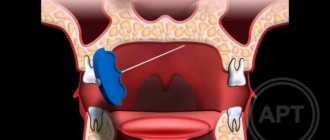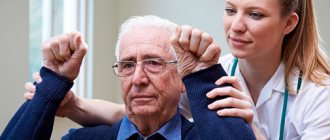Fainting (an outdated medical name is syncope) is a condition characterized by loss of consciousness and a drop in blood pressure. Metabolism slows down, sudden weakness and confusion occur. Fainting can last from a few seconds to tens of minutes.
In most cases, fainting is caused by a sudden decrease in metabolism in the brain, cerebral circulation is disrupted, and the brain stops receiving enough oxygen. Despite the fact that the brain does not function at full capacity, basic vital functions are reduced, but do not disappear completely. The patient is breathing, the heart is working.
Loss of consciousness can be caused by a variety of diseases. Sometimes fainting occurs due to a coincidence of circumstances - fatigue, stuffiness, prolonged fasting.
Before fainting, there is always a pre-fainting state, which can also last from a few seconds to several minutes. In some cases, it is enough for the patient to sit or lie down and relax the collar to avoid fainting.
Presyncope is characterized by the following symptoms:
- pulsation in temples;
- difficulty breathing - a subjective feeling of lack of oxygen;
- increased sweating;
- feeling of heat throughout the body;
- nausea, dizziness;
- tachycardia, feeling of rapid heartbeat;
- the appearance of dark spots before the eyes.
If the patient fails to sit down, he faints. In most cases, patients quickly come to their senses without outside help (although this does not mean that it does not need to be provided). Sometimes after fainting, other unpleasant symptoms are observed, for example, trembling and involuntary twitching of the limbs, the urge to urinate.
At CELT you can get advice from a neurologist.
- Initial consultation – 4,000
- Repeated consultation – 2,500
Make an appointment
Causes of fainting
There are several physiological reasons that can lead to short-term loss of consciousness. Let's look at some of them.
- Disturbances in the functioning of the autonomic nervous system. This system is responsible for vascular tone. If there is a malfunction, it cannot correctly give commands to the vessels, they contract sharply, and loss of consciousness occurs. This is the main cause of neurogenic fainting - the most common fainting.
- Diseases of the cardiovascular system. They are the cause of the so-called. cardiogenic syncope. The heart does not work well enough, the blood vessels narrow, which leads to brain hypoxia.
- Atherosclerosis and vascular diseases. This also includes ischemic attacks and strokes.
- Increased intracranial pressure. It occurs as a consequence of certain diseases - a tumor, congenital hydrocephalus, or against the background of cerebral hemorrhage, as well as after head injuries.
- Decreased blood glucose, decreased oxygen concentration in tissues. Such conditions occur with diabetes, anemia, kidney and liver failure.
- As a result of a decrease in the volume of fluid circulating in the body. May be the result of bleeding, diarrhea, or other excess fluid loss.
- Poisoning by toxins: carbon monoxide, ethyl alcohol and others.
- As a result of various psychological and psychiatric diseases. For example, with neuroses and anxiety, a common symptom is hyperventilation. The body tries to control the oxygen content, which leads to vascular spasm. In such cases, patients need to learn breathing techniques.
There are other reasons: infectious diseases, traumatic brain injuries, epilepsy attacks. In each individual case, it is necessary to undergo an examination to find out why fainting occurs.
If this is an isolated case, and there were no pathologies during medical examinations before, there is no need to worry. But if fainting recurs, you need to visit a neurologist.
True causes and provoking factors
Hypoxia—oxygen starvation of tissues, in this particular case of the brain, is caused by any relatively long-term condition accompanied by:
- or a mechanical obstruction to breathing - the flow of oxygen;
- or caused by a lack of oxygen in the blood for another reason (defect of red blood cells in some anemias, for example).
In the variant of bettolepsy, these two factors in the development of hypoxia are combined. This is a mechanical obstruction of the airways damaged by acute or chronic pathology, and a prolonged period of circulation of oxygen-poor blood.
Time measured in minutes. Time that may be sufficient for the onset of irreversible changes in the brain.
Let us add to this basis what developed by the age of 40-50, but at an earlier age, coughing fainting does not develop - atherosclerotic degeneration of blood vessels, which in itself is the cause of chronic hypoxia. As well as associated episodes of excessive blood pressure. And also arrhythmia - momentary or permanent.
It is worth adding two more strokes to the canvas, adding the following to the causes of bettolepsy:
- endocrine pathology in the form of diabetes mellitus;
- chronic allergies to everything, which developed, among other things, as a result of excessive addiction to taking medications.
When there is excess glucose in the blood, as well as when aggressive substances appear in it, either released during an allergic reaction or necessary to extinguish it, the biochemical composition of the blood and its properties change in the same way as with mechanical suffocation due to respiratory tract pathology.
Anyone who has all these treasures of dubious value has an unusually high risk of developing cough epilepsy.
But... not everyone faints with a cough! And only 2% of adults experience various types of paroxysmal conditions! And children never suffer from this disease (with the exception of cases where whooping cough serves as a background).
Why?
For the development of cough fainting, one more condition is necessary - the presence of pathological impulses from reflexogenic zones:
- The best cough syrup for children from all types
- respiratory system;
- larynx (in particular, the areas of activity of the superior laryngeal nerve);
- carotid sinus, jugular veins, aorta;
- venous sinuses of the brain.
The reaction from the pressoreceptors located in these reflexogenic zones is a necessary link that closes the fatal chain - pathological impulses from them lead to an increase in the activity of the vagus nerve, contribute to the onset of bradycardia and the manifestation of a dangerous condition - Morgagni-Adams-Stokes syndrome.
The hand of fate, or who inevitably gets sick
Accordingly, the causes of the development of bettolepsy include conditions with phenomena of increased intrathoracic pressure, as well as cerebral hypoxia, leading to disorders in the activity of the nervous system. Other provoking disorders, diseases and conditions:
- diseases of the respiratory system in the form of bronchial asthma, chronic bronchitis with an asthmatic component and outcome in pulmonary emphysema, fibrous-cavernous form of pulmonary tuberculosis, laryngitis, whooping cough;
- status that occurs during aspiration of small objects into the larynx, trachea;
- neuralgia of the superior laryngeal nerve;
- pathology of the cerebral arteries and veins in the form of vascular anomalies, compression of the vertebral arteries by osteochondrosis or atherosclerotic deposits;
- household chronic poisoning – drug addiction and alcoholism.
Factors that provoke cough fainting should also include some habits and features of life in the form of:
- wearing tight-fitting clothing;
- habits of quickly changing posture (with sudden jumping up after prolonged sitting);
- "passive smoking";
- tendency to anxious and suspicious, “psychically suffocating” states.
Why you might lose consciousness:
Types of fainting
The classification of fainting is based on the causes of loss of consciousness. There are three main types of fainting:
- neurogenic;
- cardiogenic;
- hyperventilation.
Among neurogenic syncope, in turn, a distinction is made between vasodepressor and orthostatic. The first ones are the most common, usually occurring in fairly young patients in stuffy conditions, stress, fatigue, or lack of nutrients.
Orthostatic fainting occurs when there is a sudden change in body position (usually during a sudden rise or standing). It may also be caused by taking certain medications.
Cardiogenic loss of consciousness occurs when the heart rhythm is abnormal and can accompany a heart attack. Cardiogenic syncope accounts for up to a quarter of all cases of loss of consciousness, especially among the elderly population.
Hyperventilatory syncope occurs due to rapid breathing. This symptom is characteristic of panic attacks and anxiety attacks. Sometimes this condition is called a vegetative crisis.
Come on, open your mouth
Most often, false croup occurs in children at 2-3 years of age, can recur for several years, and then goes away. If false croup occurs in a child for the first time, it is better for parents to call an ambulance. Doctors will give the child clear instructions on what to do if the situation repeats. Thus, they can stop a new attack themselves.
But inexperienced mothers and fathers are better off seeking medical help. After all, false croup can be confused with Quincke's edema, which occurs as a result of allergies, a retropharyngeal abscess, or, for example, with a foreign object getting into the throat.
If a child (especially in the first years of life) coughs suddenly, against the background of complete health, the first thing you should worry about is whether this is due to aspiration of the respiratory tract. After all, children often put everything in their mouths while playing, which is why toys containing small parts have age markings and should not be given to children under 3 years of age. With such a cough, urgent help is required. By the way, a foreign body in the respiratory tract not only interferes with breathing, but can also cause recurring pneumonia.
Clinical picture
Fainting is characterized by rapid development. Loss of consciousness occurs rapidly. Sometimes patients don’t even have time to realize that something is wrong. In other cases, typical symptoms of presyncope are observed.
Fainting is characterized by the following clinical manifestations:
- lack of consciousness;
- weak pulse;
- decreased breathing rate (bradypnea);
- lack of pupillary reaction to light;
- the patient comes to his senses within 1-5 minutes (if fainting lasts longer, this is serious);
- after fainting, pallor and weakness persist;
- for some time afterward, low blood pressure is observed;
- Dizziness and nausea may occur.
In most cases, syncope occurs when the patient is in an upright position. If the patient loses consciousness while lying down, then it is necessary to suspect a serious somatic pathology.
Symptoms
The clinical picture of bettolepsy is considered from 4 positions:
- The pathology is often observed in mature and elderly men who smoke and are obese. Often combined with bronchopulmonary diseases.
- Loss of consciousness is most often caused by chronic paroxysmal cough. Coughing is accompanied by strong contraction of the muscles of the chest and abdomen.
- Syncope can develop in any body position: lying, standing or sitting. Usually a person loses consciousness after 5 seconds of continuous coughing. Loss of consciousness is preceded by dizziness and decreased visual accuracy.
- Syncope due to continuous coughing lasts up to 10 seconds, in rare cases, loss of consciousness lasts 3 minutes. Syncope may be accompanied by cramps and heavy sweating. Some patients experience involuntary urination or defecation.
Diagnostic measures
MRI of the brain
- Cost: 14,000 rub.
More details
Diagnosis begins with an initial appointment with a neurologist. First, the doctor will try to find out in what circumstances, under the influence of what provoking factors, loss of consciousness develops. To establish a final diagnosis, you will need to undergo a series of instrumental examinations.
Thus, if cardiogenic fainting is suspected, the patient is referred for an ECG, echocardiography, and also for consultation with a cardiologist. If epilepsy is suspected, an electroencephalogram is performed. It is also common to take a blood sample to check blood sugar levels to rule out hypoglycemia. If anemia is suspected, it is necessary to conduct a blood test for hemoglobin content. If there is a possibility of neurological or organic diseases of the brain, then MRI and/or vascular examination are prescribed.
Treatment is carried out on an outpatient basis; it is enough to undergo an examination and receive treatment prescriptions.
First aid for fainting
It is important to know how to provide first aid if you lose consciousness.
- The patient must be placed on his back with the lower extremities elevated.
- Unbutton your collar, loosen your tie, remove your scarf, and provide fresh air.
- To speed up the return to consciousness, you can sprinkle the patient with cold water. For the same purposes, it is recommended to use ammonia.
If the patient does not come to within 2-3 minutes, you must call an ambulance. With prolonged fainting, even after returning to consciousness, the patient may experience some dysfunction.
Fainting should be treated by qualified professionals. Neurologists at the CELT clinic are ready to carry out all the necessary diagnostics and prescribe the most effective treatment. Modern equipment and highly qualified doctors are the key to patient health.
Make an appointment through the application or by calling +7 +7 We work every day:
- Monday—Friday: 8.00—20.00
- Saturday: 8.00–18.00
- Sunday is a day off
The nearest metro and MCC stations to the clinic:
- Highway of Enthusiasts or Perovo
- Partisan
- Enthusiast Highway
Driving directions
Night guest
False croup, or stenosing laryngotracheitis, is one of the manifestations of ARVI. It occurs in the larynx, where swelling forms, which interferes with the breathing process. A viral disease does not necessarily have to be severe for an attack to develop. Sometimes the child had only a slight runny nose and a slight cough the day before.
As a rule, false croup occurs closer to the night, but a few hours before this, the child already begins to experience warning signs. Due to the narrowing of the airways, the baby's voice becomes hoarse and a whistling sound appears when breathing. Hearing this, sometimes parents begin to suspect that their child has begun to develop bronchial asthma. But in fact, any doctor who hears such a sound will understand that this is not so. Indeed, with obstruction of the lower respiratory tract (bronchial asthma), the patient inhales normally (problems arise only with exhalation), but with false croup, on the contrary, it is not exhalation that is difficult, but inhalation. The child inhales noisily, making the so-called inspiratory breath. In addition, with false croup, a special cough occurs - barking. For some, it resembles the caw of a crow or even the sound of iron on glass. As the airway narrows, symptoms increase, requiring emergency medical attention. If necessary, emergency doctors will give the child an injection of glucocorticosteroids. Of course, not every child’s false croup can reach the suffocation phase, but if there is a predisposition to such a complication, it is better to have such drugs in your home medicine cabinet.










